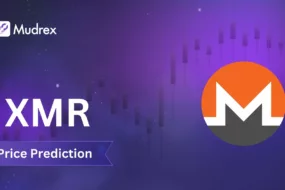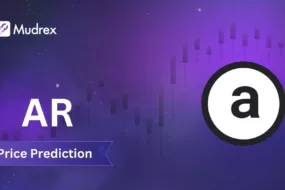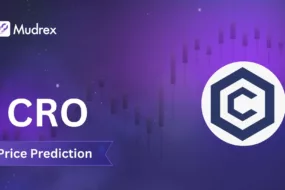
Rubic(RBC) Price Prediction
Rubic (RBC) is rapidly emerging as a crucial player in the cryptocurrency space, specializing in cross-chain and on-chain swaps. With the ability to support over 70 blockchains and 15,500+ crypto assets, Rubic’s unique selling proposition lies in its seamless integration and high liquidity.
Recent partnerships with GM² and participation in campaigns like the Zeta DeFi League have further bolstered its market position. This article delves into detailed price predictions for Rubic, exploring both short-term and long-term prospects influenced by recent developments and technical analysis.
What is Rubic (RBC)?
Rubic (RBC) is a cross-chain technology aggregator designed to streamline the process of swapping assets across multiple blockchains. Launched in October 2020, Rubic aims to simplify and enhance the user experience in decentralized finance (DeFi) by providing a unified platform that supports seamless cross-chain swaps.
Rubic’s platform integrates over 220 decentralized exchanges (DEXs) and bridges, enabling users to swap more than 15,500 assets across 70+ blockchains. Key features of Rubic include high liquidity, competitive rates, and fast transaction speeds, all within a single-click interface. Additionally, Rubic offers tools for decentralized applications (dApps) to implement cross-chain functionality through an easy-to-install widget and fully customizable SDK.
Historical Price Performance
Rubic has experienced significant volatility since its inception, reflecting the broader trends in the cryptocurrency market. In the early days following its launch, RBC saw rapid price appreciation, driven by growing interest in DeFi projects and cross-chain technology.
However, like many other cryptocurrencies, Rubic’s price has also seen periods of sharp decline, especially during market-wide corrections. In 2023, Rubic faced challenges with fluctuating prices, driven by market sentiment and the broader economic environment. Despite these fluctuations, Rubic has maintained a resilient presence in the market, with recent months showing signs of stabilization as the project continues to expand its ecosystem and partnerships.
Technical Analysis—Key Technical Indicators
Q1 2024 (January – March)
- Price Movement: The price of Rubic remained in a descending channel. The price touched the lower boundary in February and saw a minor recovery in March.
- MACD: Predominantly bearish throughout the quarter, with a slight bullish attempt in March.
- RSI: RSI fluctuated between 35-45, indicating weak momentum and occasional near-oversold conditions.
Q2 2024 (April – June)
- Price Movement: April saw a brief breakout above the channel midline, but the price quickly reverted back to the channel in May and June.
- MACD: A short-lived bullish crossover in April, followed by a flat movement, indicating market indecision.
- RSI: RSI hovered around 40-50, reflecting a balance between buying and selling pressures but still indicating underlying weakness.
Q3 2024 (July – September)
- Price Movement: The price exhibited sideways movement in July and August, with a failed breakout attempt above the midline in September, continuing within the descending channel.
- MACD: Minor bullish signals in July, followed by a bearish crossover in September.
- RSI: RSI remained around 40-45, showing a lack of strong momentum and persisting bearish sentiment.
Q4 2024 (October – December)
- Price Movement: The price will likely remain near the lower boundary of the channel, ending the year with a bearish outlook.
- MACD: Continued to show bearish momentum, with MACD flattening towards the end of the year.
- RSI: RSI stayed below 40, indicating potential oversold conditions and persistent bearish pressure, which will most likely continue in the remaining months.
Price Prediction for 2024
| Month | Price (USD) | Prediction |
| September | $0.037 – $0.045 | A failed breakout attempt might lead to further decline towards the lower channel boundary. The price could remain under pressure unless significant positive news alters market sentiment. |
| October | $0.038 – $0.046 | The price may continue to test the lower boundary of the channel, with any new partnerships or technology integrations potentially providing support. However, the bearish trend may persist if market sentiment remains negative. |
| November | $0.037 – $0.044 | Continued bearish momentum is likely, with the price staying near the lower boundary of the channel. Any significant developments in the broader crypto market or within Rubic’s ecosystem could influence the price. |
| December | $0.038 – $0.045 | The year might end with Rubic trading near the lower channel boundary. While there could be short-term bullish attempts driven by news of platform upgrades or new partnerships, the overall market conditions will play a crucial role in determining the year-end price. |
Expert Opinions on Short-Term Price Movements
Market analysts suggest that Rubic’s short-term price movements will be heavily influenced by its ability to secure and expand partnerships, particularly in the DeFi space. The ongoing development of cross-chain functionality and the successful integration of emerging blockchains could provide upward momentum. However, experts caution that broader market conditions and investor sentiment will play a significant role, with potential price spikes driven by positive developments in the broader crypto market.
Long- Term Price Prediction for Rubic
| Year | Price (USD) | Prediction |
| 2024 | $0.038 – $0.045 | The price is expected to fluctuate within this range, driven by the ongoing developments in Rubic’s partnerships and cross-chain expansion. Short-term price spikes are likely due to campaign-driven user engagement, but overall, the price may struggle to break out of the descending channel until market sentiment improves. |
| 2025 | $0.045 – $0.18 | Rubic could experience significant growth as the adoption of cross-chain technology becomes more widespread. Key partnerships and the successful implementation of its roadmap could push the price toward new highs. Market conditions and further integration with major blockchain ecosystems will play a critical role in sustaining price gains. |
| 2026 | $0.18`- $0.35 | The expansion of Rubic’s ecosystem, particularly with new blockchain integrations, could drive further price increases. The coin’s utility in DeFi applications and its growing user base may lead to sustained demand for RBC tokens. However, the broader market environment and potential competition could influence the rate of growth. |
| 2027 | $0.35 – $0.45 | Continued innovation in cross-chain technology and the maturation of the DeFi space are expected to support Rubic’s price growth. The token may see steady appreciation as it becomes more integrated into various blockchain projects, with increasing transactional volumes boosting its value. |
| 2028 | $0.45 – $0.60 | As Rubic solidifies its position as a leading cross-chain aggregator, the price could rise significantly. Market adoption and the expansion of Rubic’s functionality will be key drivers. However, competition from emerging cross-chain platforms could impact its market share. |
| 2029 | $0.60 – $0.75 | The long-term growth of Rubic may be driven by its role in facilitating interoperability across blockchains. As more projects leverage Rubic’s technology, the demand for RBC tokens is expected to increase, potentially leading to new all-time highs. The price will also be influenced by the overall health of the crypto market. |
| 2030 | $0.75 – $1.00 | By 2030, Rubic could reach or approach the $1 mark if it continues to innovate and expand its user base. The token’s utility in governance, DeFi, and cross-chain applications will be central to its value proposition. Long-term market trends, including regulatory developments and technological advancements, will play a significant role in determining its ultimate price. |
| Beyond 2030 | $1.00+ | If Rubic continues to lead in cross-chain technology and expands its ecosystem, the price could surpass $1, with potential for further growth depending on market adoption and global regulatory environments. Long-term success will depend on Rubic’s ability to adapt to new market conditions and maintain its competitive edge. |
Price Prediction for 2025
In 2025, Rubic is expected to continue its growth trajectory as the DeFi ecosystem matures and cross-chain technology becomes increasingly essential. With the potential for further integration with major blockchain networks and the expansion of its user base, RBC could see a significant price increase. Analysts forecast that if Rubic continues to innovate and secure strategic partnerships, the price could reach new highs, potentially surpassing previous resistance levels.
Price Prediction for 2026
By 2026, Rubic’s price could be influenced by the overall adoption of cross-chain solutions in the crypto space. As more projects seek to integrate Rubic’s technology for seamless asset swaps, the demand for RBC tokens could increase. Additionally, developments in blockchain technology, such as improvements in scalability and security, may further support RBC’s price growth. However, market volatility and regulatory developments could pose challenges, making it crucial for Rubic to adapt and innovate continuously.
Price Prediction for 2027
In 2027, Rubic’s price could see steady growth as the platform becomes a staple in the DeFi and cross-chain landscape. The ongoing expansion of its ecosystem, coupled with increasing utility for RBC tokens, may drive long-term price appreciation. Analysts predict that if Rubic continues to deliver on its roadmap and maintains a strong community, it could achieve significant milestones, pushing its price higher.
Price Prediction for 2028
By 2028, Rubic might solidify its position as a leading cross-chain aggregator, with widespread adoption across various blockchain networks. The increasing use of Rubic’s platform for DeFi applications, NFTs, and other blockchain-based solutions could contribute to a sustained upward trend in RBC’s price. However, competition from other cross-chain platforms and potential market disruptions could influence the pace of growth.
Price Prediction for 2029
In 2029, Rubic’s long-term growth prospects could be driven by the continuous evolution of the crypto market and the increasing importance of interoperability between blockchains. As more assets and projects migrate to Rubic’s platform, the demand for RBC tokens is expected to rise. Analysts suggest that if Rubic remains at the forefront of cross-chain innovation, its price could reach new heights, although market dynamics will play a critical role.
Price Prediction for 2030 and Beyond
Looking towards 2030 and beyond, Rubic is poised to benefit from the broader adoption of blockchain technology across industries. As the need for cross-chain solutions becomes more pronounced, Rubic could see exponential growth in its user base and transaction volume. Analysts predict that RBC could experience significant price appreciation, potentially reaching levels that reflect its integral role in the blockchain ecosystem. However, long-term success will depend on Rubic’s ability to adapt to changing market conditions, technological advancements, and regulatory developments.
Factors Influencing Price Predictions
Several factors are expected to influence Rubic’s price in the coming years:
- Partnerships and Integrations: Ongoing partnerships, such as those with GM² and zkLink, are likely to enhance Rubic’s utility and increase demand for RBC tokens.
- Market Sentiment: The broader market sentiment, as indicated by the Fear & Greed Index, will play a crucial role in driving short-term price movements. Positive sentiment could lead to significant price spikes, while negative sentiment might result in declines.
- Technology and Ecosystem Growth: The continuous expansion of Rubic’s ecosystem, including the integration of new blockchains and the development of cross-chain functionality, will be key drivers of price growth.
- Regulatory Environment: As the regulatory landscape for cryptocurrencies evolves, Rubic’s ability to comply with new regulations and maintain its competitive edge will impact its long-term price potential.
- Market Adoption: The wider adoption of Rubic’s platform by dApps, DeFi projects, and individual users will directly influence the demand for RBC tokens, driving price appreciation.
Rubic (RBC) is positioned for significant growth, supported by its expanding ecosystem and strategic partnerships. As the platform continues to integrate new technologies and blockchains, its potential for price appreciation remains strong. The monthly and yearly predictions provided here offer a roadmap for investors, highlighting key factors that could drive Rubic’s value. While market volatility is inherent, Rubic’s robust infrastructure and ongoing innovations suggest a promising future. Staying updated with Rubic’s developments will be crucial for anyone looking to capitalize on its growth trajectory.




